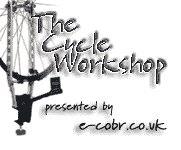
|
The Cycle Workshop is just one part of a significant cycling specific advice, information and shopping resource produced and managed by e-cobr marketing. |

cycling advice, information, news
and shopping for every cyclist
 |
|
 cycling advice, information, news and shopping for every cyclist |
|
||
|
Site design and maintenance by LPS Marketing |
||